With another report of an explosion in the news seemingly every couple of days, battery safety is something that should be paramount in the mind of nearly every vaper. It is important not to overstate the problem, though. After all, smoking causes approximately 90,000 fires and 500-plus deaths each year in the United States alone. There is no question that fire-related damage and injury would be greatly reduced if all smokers switched to e-cigarettes.

However, lithium-ion batteries store a great deal of energy in very small containers and sometimes behave in unpredictable ways — and that might make you nervous when you see a reports of vape battery explosions in the news. If you are concerned about the proper usage of vape batteries, you’re in the right place. I created this article after extensive research with the hope of creating the Internet’s most comprehensive guide to vape battery safety. I hope you’ll agree that this article is, quite simply, the best resource of its kind available anywhere online.
Revolutionary New Disposable Vape
The new Lost Mary MT15000 lasts up to 15,000 puffs and features the incredible new Pulse Mode that allows you to get double the vapor on demand. A front display shows the device's e-liquid supply and battery life at a glance. Try the Lost Mary MT15000 Sample Pack, which includes three different flavors, for just $39.99. Take an additional 20% off with the coupon code VAPEGRL.
Proper Vape Battery Safety Isn’t Difficult
I’m no engineer. It took quite a lot of reading to gain the understanding of vape battery safety that I now have, and I wrote this article with the goal of making it as easily understood as possible. Although this is a lengthy article, I think you’ll agree that battery safety ultimately boils down to just a few simple points that are easy to grasp and to remember. I sincerely hope that you’ll find this work useful.
Key Vape Battery Terms to Understand
Before we start digging too deeply into battery safety, it’ll be helpful for you to understand a bit of vape battery terminology because I’ll be referring to some of these terms throughout the article.
- Continuous Discharge Rate (CDR): This figure is measured in milliamps or mA, and it defines the current that a battery can safely deliver without overheating. You should always know the CDR of a vape battery before buying it. Battery brands are known to make exaggerated performance claims, though, so you should always stay well below a battery’s advertised CDR.
- Milliamp-Hours (mAh): This figure describes the energy capacity of a battery. A battery with a capacity of 1,000 mAh delivers one amp of power for one hour before it dies. The CDR and mAh of a battery are inversely related to each other, which means that a battery with a higher CDR will have a lower capacity and vice versa.
- High-Drain Battery: A high-drain battery is a battery that’s capable of delivering a high-amperage current for a short period of time. Generally speaking, all good vape batteries are high-drain batteries.
- Thermal Runaway: Thermal runaway describes the process in which a lithium-ion battery overheats. In this process, an uncontrollable chemical reaction takes place, and the battery begins to vent hot gas and flames. Because the fire increases the rate of the reaction, there is essentially no way to halt thermal runaway once it begins.
- Regulated Mod: A regulated mod has power-regulation circuitry that controls the rate at which the battery discharges. A regulated mod will have safety features such as temperature protection, battery cell monitoring and short circuit detection. An unregulated mod — also known as a mechanical mod — has none of those features. Virtually every vape mod on the market today is regulated. Mechanical mods have become quite rare, which is a good thing.
Always Check Your Batteries’ Wrappers
- Don’t use batteries with visible physical damage.
- Unless you feel comfortable re-wrapping batteries yourself, recycle batteries with damaged wrappers.
- Only use batteries in the correct orientation.
I have been unfortunate enough to review a vaping device that damages batteries: the Joyetech eVic VTC Mini (Review). The VTC Mini has a side-mounted battery compartment with an extremely tight fit, and I was unlucky enough to damage the wrappers of two expensive batteries while using it. Why can a damaged battery lead to an unsafe vaping device? As you likely already know, a battery has positive and negative poles. The positive pole is the raised or flat circle at the top of the battery, and the area around it is insulated from the rest of the battery. However, the entire remaining portion of the battery functions as the negative pole. The only thing that insulates it is the battery’s wrapper.
So, suppose the battery’s wrapper is damaged. You could have a situation in which the side of your battery touches the inside of your mod, which could be metal. Since this isn’t the intended path for electricity through the mod, you’ll have a short. In the case of a power-regulated mod with safety features that function as they should, the mod simply won’t work.
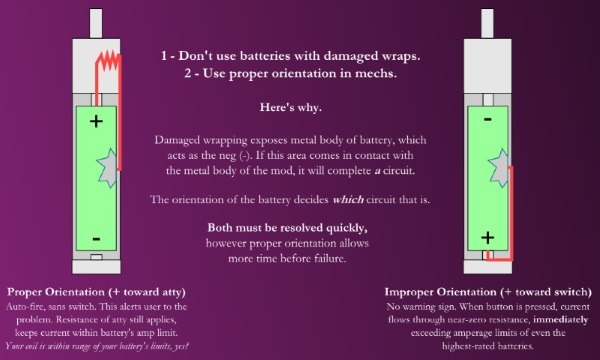
If you have a mechanical mod, though, it could be a completely different story. Take a look at the graphic above (image source). Few mechanical mods have fuses, and none have safety timers to prevent overheating. If the battery causes a short and it is installed with the correct orientation, the mod will start to fire as if you were holding the fire button. You’ll have a very brief time to correct the problem before overheating occurs.
If you happen to have the battery installed with the incorrect orientation, though, you won’t have the resistance of the atomizer slowing down the battery’s discharge. Current will flow from the battery through the body of the mod at almost zero resistance, potentially causing anything from electric shock to the battery entering thermal runaway.
Avoid Unattended Charging
- For maximum safety, charge vape batteries only when you are available to handle any problems that might occur.
When you read the instruction manual for almost any device containing a lithium-ion battery, you’ll see a blurb warning you not to charge the device unattended. However, people leave devices such as laptops and mobile phones connected to their chargers every day while they work or sleep, mostly without incident. Why? Because the vast majority of the time, a battery’s charger detects when the target voltage has been reached and shuts off.
For maximum safety with vape batteries, though, you’re better off disconnecting your batteries when they are finished charging unless you have a standalone battery charger that you trust. This FEMA document describes the circumstances surrounding 25 different e-cigarette battery fires through late 2014. In at least four incidents, it appears that the battery caught fire due to over-voltage conditions during unattended charging.
Store and Transport Your Vape Batteries Properly
- Keep your vape batteries away from heat and metal objects.
A large percentage of vape battery explosions don’t happen during charging or use — they happen because people store or transport their spare batteries improperly. If you use a vaping device with removable batteries, always follow these three safety tips.
- Don’t ever carry vape batteries in your pocket. If a battery touches other metal objects such as coins or keys, a short circuit could occur.
- If you need to transport spare batteries, put them in a padded carrier that separates the batteries from one another and protects them from damage.
- Don’t store your batteries in extreme heat or cold.
Use the Correct Charger
- Charge an e-cigarette battery with the recommended charger supplied by the manufacturer.
Plenty of e-cigarette batteries are thread-compatible with one another. KR-808, 510 and eGo e-cigarettes are all fairly standardized types that make it easy to use refill cartridges from another manufacturer with your existing e-cigarette. Since many of the thread types are standardized, it may appear that you have several chargers that fit more than one brand of e-cigarette battery if you own more than one e-cigarette. However, that doesn’t necessarily mean that all of your batteries charge according to the same specifications. You should only charge your e-cigarette batteries using the charger supplied by the manufacturer. Thankfully, modern USB-based devices largely eliminate the issue of proprietary battery chargers.
Watch for Counterfeit Batteries
- Buy your batteries from a trusted supplier and be certain of their authenticity.
If you’ve followed the battery wrapping link above, you know how easy it is to remove a battery’s wrapper and replace it with a new one. Unscrupulous sellers have taken this idea even further by removing the wrappers from generic batteries — old laptop cells, for example — and replacing them with counterfeit wrappers from well-known battery brands such as LG and Sony. Eventually, some of those counterfeit batteries find their way to online marketplaces such as Alibaba and eBay. In at least one case, a major e-cigarette company has inadvertently purchased a stock of counterfeit batteries and sold them to the public.
Why do counterfeit batteries often go unnoticed? For the most part, the demands that users place upon their batteries keeps them well below their limits. Suppose you’re using a 0.5-ohm coil with a battery that holds 4.2 volts on a full charge. That’s a load of 7.75 amps, which the vast majority of batteries used in vape mods can handle without any problem. You could have a counterfeit battery with a true maximum discharge rate of 10 amps rather than the 35 amps marked on the wrapper, but you’d never know the difference if you aren’t placing that level of demand on the battery. However, that doesn’t mean that the battery’s other components are also up to snuff, and that’s where safety issues could creep in.
Whatever brand of battery you prefer, it’s wise to do some reading on the manufacturer’s website to learn how to spot fakes. Many of the most popular battery manufacturers now employ anti-counterfeiting measures.
Don’t Ever Stack Your Batteries
- Don’t stack batteries in an unregulated mod.

Don’t do this. Ever.
In the early years of the vaping industry, the most serious battery safety issue was the usage of stacked batteries in unregulated mechanical mods. Stacking two batteries runs them in series, doubling the total voltage. In the days before variable mods, sub-ohm tanks and rebuildable atomizers were available, stacking batteries was one way to greatly increase the vapor output of an e-cigarette. However, stacking batteries greatly increases their load. If the batteries aren’t up to the task or aren’t treated correctly, they could overheat and enter thermal runaway or explode.
With all of the devices and attachments available today, vape mod can generate all the vapor you could ever want without creating battery usage conditions that are inherently unsafe. In other words, there is no reason — ever — to stack batteries in an unregulated mod.
Use the Right Battery Chemistry: IMR vs. INR vs. ICR
- INR and IMR batteries are the safest types for most e-cigarettes.
The two most popular battery forms of battery chemistry used in vaping today are Lithium Manganese Oxide (IMR) and Lithium Manganese Nickel (INR). These “high drain” batteries have the ability to operate at relatively low temperatures under fairly high loads while remaining thermally stable except in over-current or short circuit conditions.
Lithium Cobalt Oxide (ICR) batteries used to be somewhat popular among e-cigarette users because they often have very high mAh ratings relative to relative to their size. In other words, an ICR battery typically works for a very long time between charges. However, ICR batteries can’t handle the same amperage loads that IMR and INR batteries can. This article does an excellent job of explaining the various types of batteries used for vaping.
In short, for most vaping applications, you should be using INR or IMR batteries. ICR batteries aren’t appropriate for most of the devices that people currently use. If you do use an ICR battery, use one with a protection circuit on a device that drives higher-resistance atomizers or cartomizers. Familiarize yourself with Ohm’s law, and be certain that your battery is capable of handling the load that you place upon it. That brings us to our next topic…
Look Out for Exaggerated Performance Claims
- Your battery probably can’t handle a continuous load of 35 amps.
Manufacturing batteries is expensive — really expensive. The vast majority of the battery cells used in vaping devices are made by very large companies whose names you would immediately recognize — companies such as Sony, Samsung and LG. However, the batteries themselves often have entirely different logos on them, such as Hohm or EFest. That’s because smaller companies buy the cells from the original manufacturers and re-wrap them for sale.
This is an accepted practice; the companies that resell batteries may even add value by performing additional testing on their cells or adding custom circuit boards. However, some problems have begun to creep in; at least one company has been caught making performance claims of its batteries that were untrue. In one case, a battery was marked as supporting a continuous discharge of 20 amps when the cell only supported 4 amps.
What does this mean? It means that you shouldn’t just be confident that the wrapper on your battery is genuine — you should also know the specifications of the cell under the wrapper. Very few battery manufacturers — perhaps none — actually rate their cells for use under a continuous 35 amp discharge. If you’re using an 18650 battery, you should stay well below that kind of load. If you can’t do that, upgrade to a larger battery such as a 21700 cell. Larger batteries can typically handle higher loads safely.
Understand Protected vs. Unprotected Batteries
- If you do use an ICR battery, use a protected battery and high-resistance attachments.
As I mentioned above, INR and IMR batteries are the types that the majority of today’s e-cigarette users prefer. INR and IMR batteries are popular because of their ability to remain stable under heavier loads. An INR or IMR 18650 battery, for example, can often remain stable under a continuous load of 20 amps and sometimes more. An ICR battery of the same size will typically have a greater capacity in mAh but will only remain stable under a continuous load of up to 5 amps or so.
For older vape mods that typically used attachments with resistances of 2 ohms and higher, this wasn’t a problem. A 4.2 volt battery and 2.0 ohm atomizer, for example, would produce a load of just 2.1 amps. With most modern vaping setups, though, ICR batteries become unusable. Use a 0.5 ohm atomizer at 4.2 volts, and you’ll have a load of 8.4 amps.
So, on a modern mod, you shouldn’t be using ICR batteries. If you choose to use an ICR battery anyway, it should be on a device with high-resistance attachments, and you should know exactly how much of a load you’ll be asking the battery to handle. Also, be certain that you are only using a protected ICR battery, which has a built-in protection circuit that disables the battery in over-current conditions.
Don’t Use an Over-Discharged Battery
- Don’t over-discharge your batteries. If a battery’s voltage is too low, dispose of it.
A typical lithium-ion battery holds 4.2 volts on a full charge. It isn’t “dead” at 0.0 volts, though — a lithium-ion battery is actually fully depleted at more like 3.0 volts. If you’re using a regulated mod, this isn’t a problem; the mod will shut off and tell you to charge the battery at well above 3.0 volts.
If you have a mechanical mod, though, maintaining the health of the battery is up to you. Some people monitor battery voltage manually. Others simply swap out their batteries as soon as vapor production begins to decrease.
An over-discharged lithium-ion battery cannot be charged safely. When a lithium-ion cell is over-discharged, the electrolyte reacts with the electrodes, oxidizing them and possibly converting them into conductors. This can result in a short, causing the battery to overheat and vent during charging. So, the best practice is to recharge your batteries long before they reach 3.0 volts.
Use a Resistance Tester if You Build Your Own Coils
- If you build your own coils, check their resistance — every time.
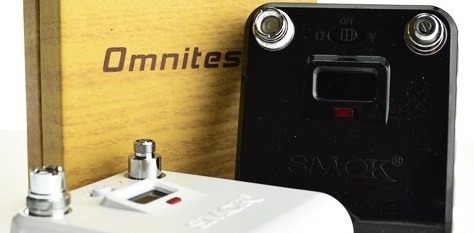
If you wrap your own atomizer coils, there is simply no excuse not to own a resistance tester. I use this model from SMOK, which has both male and female 510/eGo connections and costs just $19.99. It also serves as a convenient platform for building.
Some people who build atomizer coils for power-regulated mods rely on their mods to tell them the resistance of their coils. That isn’t a good idea, though, because you do still have to press the fire button to obtain the resistance of a coil. In that brief moment, you could experience a problem if the coil has a short or the resistance is too low and the mod’s protective circuitry fails to work as it should.
If you have a mechanical mod without a fuse, though, your device doesn’t have protection. In this case, you really need to confirm the resistance of your atomizer coils before using them.
If You Use a Mechanical Mod, Make Sure It Has Vent Holes
- A well-vented mod could save your life in the event of battery failure.
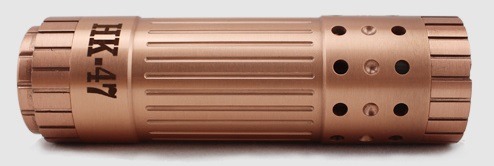
Vent holes give hot gas a chance to escape before it turns your mod into a pipe bomb.
When lithium-ion battery fails catastrophically, it begins to vent hot gas. In this event, the amount of time that you have to react depends largely on the ventilation of your device. If your device has plenty of large ventilation holes, the gas can escape, hopefully giving you enough time to quickly move the device to a safe location.
However, vaping devices — particularly mechanical mods — can be made by almost anyone and come in a very wide range of quality levels. I have seen some mechanical mods that provide almost no ventilation at all. If a battery should fail inside a mod that has no vent holes, pressure may build up inside the mod. This can create a situation in which the mod behaves as a sort of pipe bomb, making an already dangerous situation potentially far more deadly.
Mechanical mods are inherently unsafe, and I really don’t recommend using one at all. If you’re going to use one, though, make sure that it has vent holes.
Consider Using a Fuse if You Have a Mechanical Mod
- If you use a mechanical mod, implement a fuse for better safety.
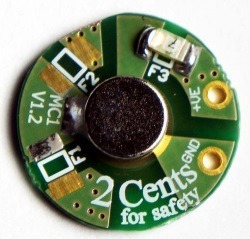 An inexpensive fuse such as the VapeSafe can greatly enhance your safety, especially when using mechanical mods which typically have no onboard safety features of their own. A VapeSafe fuse connects magnetically to the top of the battery and automatically breaks the circuit when the current is too high. Some VapeSafe fuses can even trip multiple times before you need to discard them. So, why doesn’t everyone use VapeSafe fuses? At the highest, VapeSafe fuses will trip at about 7 amps. That means you won’t be able to use a coil with a resistance under about 0.7 ohms. For serious sub-ohm vaping, that really isn’t going to work. If you aren’t into competition vaping or cloud chasing, though, consider adding a fuse to your setup if you use a mechanical mod. Although a fuse isn’t a 100-percent guaranteed effective way of insuring e-cigarette battery safety, it does add an extra measure of protection that’s absolutely worth having.
An inexpensive fuse such as the VapeSafe can greatly enhance your safety, especially when using mechanical mods which typically have no onboard safety features of their own. A VapeSafe fuse connects magnetically to the top of the battery and automatically breaks the circuit when the current is too high. Some VapeSafe fuses can even trip multiple times before you need to discard them. So, why doesn’t everyone use VapeSafe fuses? At the highest, VapeSafe fuses will trip at about 7 amps. That means you won’t be able to use a coil with a resistance under about 0.7 ohms. For serious sub-ohm vaping, that really isn’t going to work. If you aren’t into competition vaping or cloud chasing, though, consider adding a fuse to your setup if you use a mechanical mod. Although a fuse isn’t a 100-percent guaranteed effective way of insuring e-cigarette battery safety, it does add an extra measure of protection that’s absolutely worth having.
Consider Buying a Standalone Battery Charger
- A better charger means a safer battery.
Using a vape mod with removable batteries and a standalone charger may add an extra measure of safety. For example, I have a Nitecore battery charger that I’m quite happy with. It’s available in two-bay and four-bay versions, charges all of the most common battery types and sizes, automatically selects the correct charging mode for each bay independently and stops charging when the cycle is complete.
However, all of this technology costs money. If a standalone battery charger costs about as much as an inexpensive mod with a built-in battery, how much money do you think the charging circuitry in the mod is worth? This article does an excellent job of comparing the power quality of various USB chargers, including inexpensive knock-offs. Although battery failures during charging are rare, they’re even rarer with top-quality chargers.
Consider Charging Batteries in a Lipo Bag
- If your battery attaches to the charger via a cable, consider charging it inside a Lipo bag.
Some vapers advocate charging batteries in Lipo bags. Lipo bags are constructed from fire-resistant material designed to contain the damage if a battery enters thermal runaway. Here’s the thing, though — to contain a potential fire, a Lipo bag should remain closed while the battery charges. This means that the bag will also restrict ventilation. In the case of the typical lithium polymer batteries used for radio-controlled cars and similar devices, the battery connects to the charger with wires. During charging, the battery should only become slightly warm. The charger — which can become very warm — remains outside of the Lipo bag for ventilation.
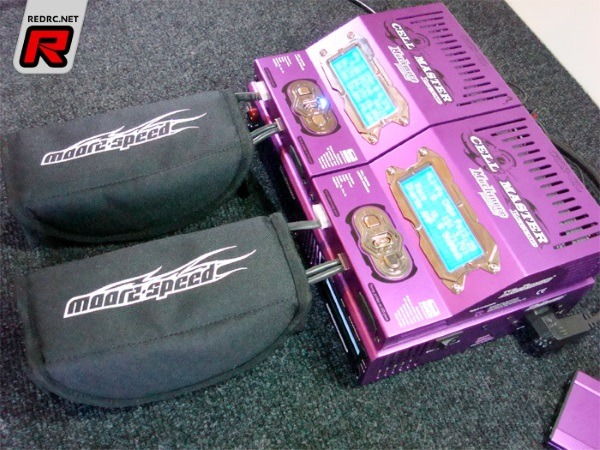
Lipo batteries charging in bags. Note that the charger itself remains separate from the bags. (Image source)
Now, consider the charging scenario you’ll encounter with most vape mods. If you have a mod with a permanent internal battery, the charging circuitry is inside the mod as well. If you have a mod with a removable battery, you charge the battery inside a charger. Either way, you can’t disconnect the battery from the charging circuitry as you can with a Lipo pack. So, the possibility exists that, due to heat insulation, charging an e-cigarette battery in a Lipo bag might actually do more harm than good.
Rather than charging their e-cigarette batteries in Lipo bags, some people attempt to build charging environments that isolate batteries to prevent the potential spread of fires. For example, some people charge their batteries in cooking pots filled with sand or gravel. Only you can decide, of course, whether the inconvenience of doing something like this outweighs the potential risk of a fire. Whatever you choose to do, though, there simply is no replacement for being there while your batteries charge.
Know What to Do in an Emergency
As we near the end of this guide, I’d like to remind you that as scary as vape battery fires may be, they’re extremely rare. They’re much, much rarer than fires caused by cigarettes, and switching from smoking to vaping is definitely the right decision from a property safety standpoint. With that being said, it’s still important to know what to do in the event of an emergency.
- If your vaping device emits a strange smell during charging or feels extremely hot to the touch, immediately disconnect the charging cable and get a fire extinguisher ready. I’d advise against touching or moving the device in case thermal runaway has already begun. Touching a lithium-ion battery during thermal runaway will cause a severe burn.
- If your device emits a strange smell or feels extremely hot during use, immediately drop it on a fire-resistant surface and get a fire extinguisher ready.
- A dry chemical A-B-C fire extinguisher is suitable for putting out a lithium-ion battery fire. You can find one on Amazon or at your local home improvement store.
How to Dispose of a Vape Battery Safely
I’d like to close this article with an important reminder. You’re not just responsible for the safety of your vape batteries while you use them — you’re also responsible for what happens after you’re done with them. Battery fires can and do happen in waste processing facilities, and that’s just one reason why you should never dispose of a vaping device or vape battery in your regular household trash.
Your local waste authority can provide instructions for disposing of vape batteries, most likely through a hazardous waste collection program. You may also have local stores with collection boxes for used batteries. If a store near you has a collection box that accepts lithium-ion batteries, put each battery in its own plastic bag to isolate the metal terminals before dropping the battery in the collection box.

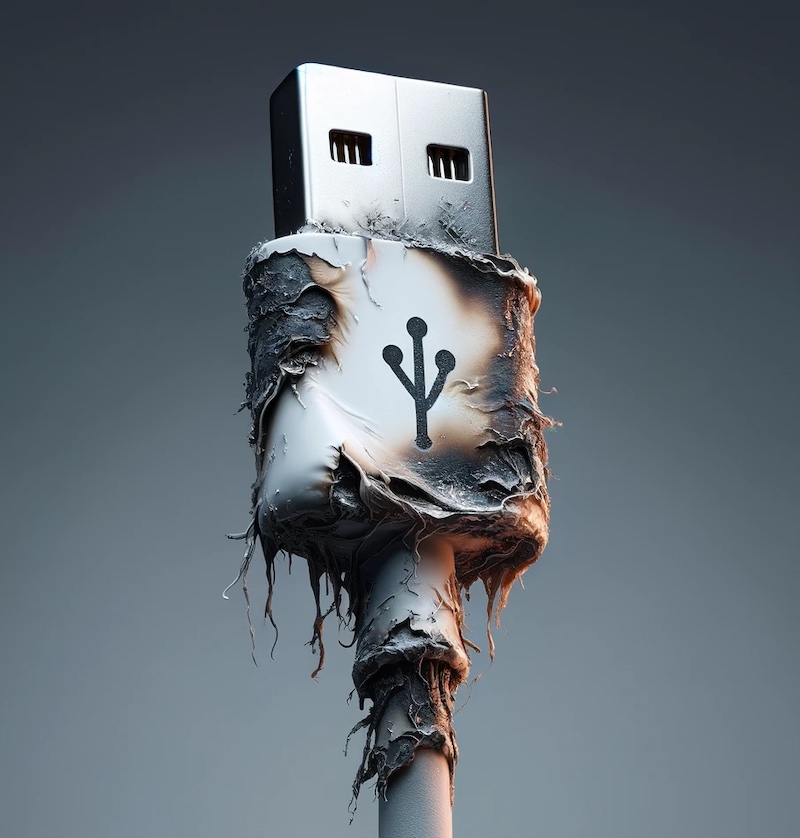
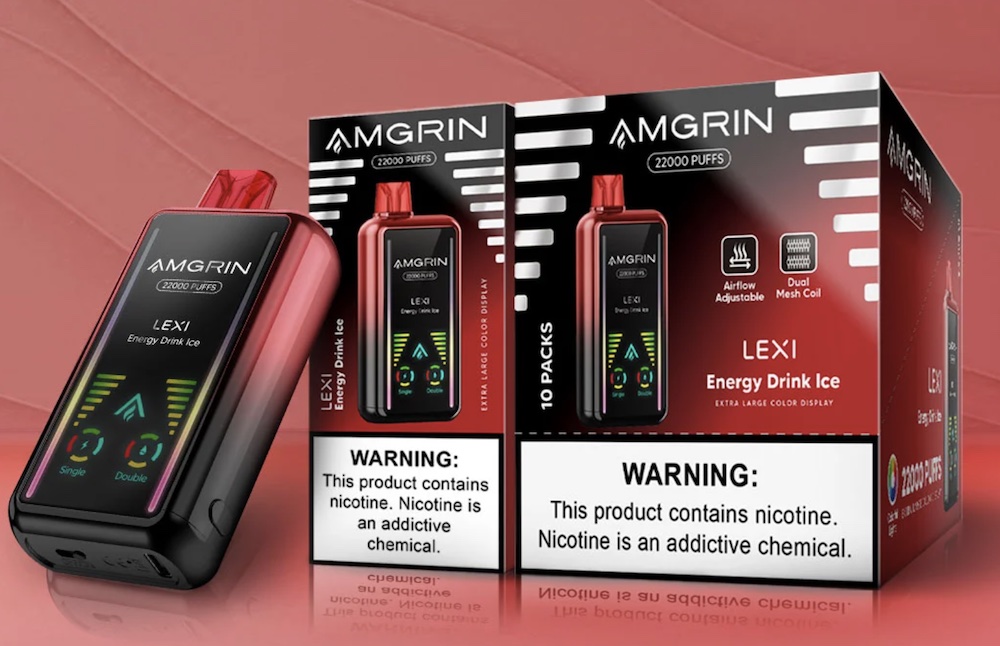

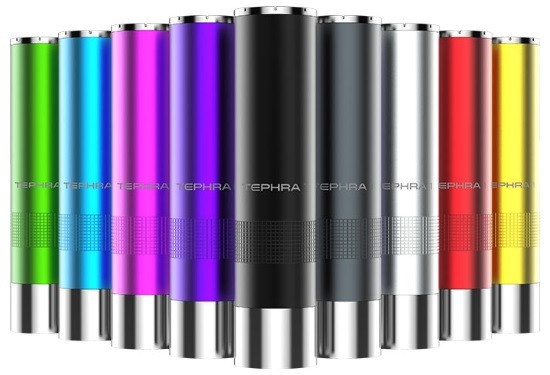

0 Comments